Under Construction 
Filters are used in:
- Vacume Cleaners
- HVAC filters
- dust masks
- smoke hoods
- Auto air filters
This page is primarily about Heating Ventilating and Air Conditioning (HVAC) filters
HVAC Filters
Air filters serve several purposes:
- Protecting the motors, fans and coils of HVAC systems from getting a buildup of dust, dirt and debris
- Keeping your house clean by removing dust and lint particles
- Protecting your health my removing allergens and some micro organisms
There several kinds of HVAC filters.
- Fiberglass filters - Trap larger particels including some dust. They are cheap, but be replaced monthly.
- Electrostatic Filters - Use static electricity to remove particles from the air. The front of the filter charges any particles with static electricity. Then, as the particles move through the they are attract and stick to the rear layers.
- They are equivalent to a MERV 4-9, but claim to be better at removing allergens. They cost from $150 - $450, so are cheaper in the long run, but need to be washed every month or so.
- Pleated filters - Made of a polyester fabrics or cotton with MERV ratings typically from 8 - 16. They gain efficiency because they have an increase in surface area.
- UV Filters - Use ultraviolet lights to kill bacteria and viruses in your home.
Different Types of HVAC Filters Explained | Conditioned Air
Carbon Layers made of activated carbon, also called activated charcoal, carbon air filters can help trap odors.
How It Works: Carbon Filter | 3M
Location:
Filters may be either
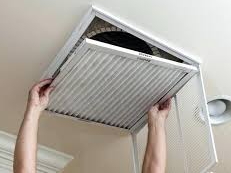 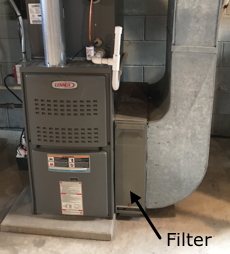 1. Behind the return duct grills in the ceiling or on a wall in the house. Usually a 1 inch thick filter.
1. Behind the return duct grills in the ceiling or on a wall in the house. Usually a 1 inch thick filter.
or 2. Where the main return duct connects to the HVAC system in the basement or attic. These filters can be anywhere from 1 to 5 inches thick.
There are several rating systems:
MERV Rating (Minimum Efficiency Reporting Value) EPA
MERV is the primary rating system used in the industry, both domestically and internationally. Established by the American Society of Heating, Refrigerating, and Air Conditioning Engineers, MERV rates a filter’s ability to capture and hold particles and pollutants.
See below.
MPR (Micro-Particle Performance Rating) -
A rating system developed by 3M (sold at Lowes). It rates the manufacturer’s filters and their ability to capture airborne particles smaller than 1 micron
FPR (Filter Performance Rating) -
A rating system developed by The Home Depot for brands sold through their stores, including Honeywell. It utilizes a color and number scale from 4 to 10 that closely resembles MERV rating
HEPA (High Efficiency Particulate Arresting Filters) are a popular filter type used in indoor air cleaners and vacuum cleaners. They represent state of the art technology and are one of the most efficient types of air cleaner filters used for general air cleaning. By definition, a true HEPA filter in contrast with a near HEPA filter, must remove 99.97% of all particles of 0.3 microns mean diameter.
That micron size (0.3) is referred to by scientists as the MPPS, or the most penetrating particle size. Scientists have found that particles of that size evade air filters more than larger or smaller particles. We’ll get into why in a little bit.
MERV Rating (Minimum Efficiency Reporting Value)
MERV is the primary rating system used in the industry, both domestically and internationally. Established by the American Society of Heating, Refrigerating, and Air Conditioning Engineers, MERV rates a filter’s ability to capture and hold particles and pollutants.
8 = Standard; 11 = Superior; 13 = Best
The company which installed my Lenox system recommends 11, but says you can use 16 if you want to filter many viruses.
MERV
Value |
Av. Particle Size Efficiency | Types of things trapped |
0.3 - 1 Micron | 1 - 3 Micron | 3 - 10 Micron |
| MERV 1 | - | - | Less than 20% | Pollen, dust mites, standing dust, spray paint dust, carpet fiber |
| MERV 2 | - | - | Less than 20% |
| MERV 3 | - | - | Less than 20% |
| MERV 4 | - | - | Less than 20% |
| MERV 5 | - | - | 20% - 34% | Mold spores, hair spray, fabric protector, cement dust, animal dander, and dust mite droppings (highly allergenic) |
| MERV 6 | - | - | 35% - 49% |
| MERV 7 | - | - | 50% - 69% |
| MERV 8 | - | - | 70% - 85% |
| MERV 9 | - | Less than 50% | 85% or better | Good for homes with occupants who have COPD, allergies, astma and other respiratory conditions.
Humidifier dust, lead dust, auto emissions, milled flour.
Almost as effective as HEPA filers |
| MERV 10 | - | 50% - 64% | 85% or better |
| MERV 11 | - | 65% - 79% | 85% or better |
| MERV 12 | - | 80% - 89% | 90% or better |
| MERV 13 | Less than 75% | 90% or better | 90% or better | Viruses, bacteria, most tobacco smoke, proplet Nuceli (sneeze) and carbon dust. Used in commercial manufacturing operations. Bacteria, |
| MERV 14 | 75% - 84% | 90% or better | 90% or better |
| MERV 15 | 85% - 94% | 90% or better | 90% or better |
| MERV 16 | 95% or better | 90% or better | 90% or better |
Source: What does MERV Rating mean | CoolRay.com
According to Sun Kool AC, Inc. a residential system will not accommodate filters with MERV ratngs above 12 without modifications.
The company which installed my Lenox system said that is not true.
True HEPA filters with a MERV between 17 and 19 are defined by the
Institute of Environmental Sciences and Technology. (IEST) method as having a minimum efficiency between 99.97% and 99.999 % in removing 0.3 μm particles.
A MERV of 20 is rated for 0.1 - 0.2 μm particles.
Source: HVAC-Talk.com
Particle size:
Dust: 1-12 micron
Bacteria: 0.2 to 20 micron
Smoke: 0.01 - 1 micron
Virus: 0.02 to 0.4 micron [rhinovirus (cold) = 0.02 μm, Flu = 0.1 μm]
μm = micron
See Size in reference.
MERV (Minimum Efficiency Reporting Values)
MERV Rating Average Particle Size Efficiency in Microns
1-4 3.0 - 10.0 less than 20%
6 3.0 - 10.0 49.9%
8 3.0 - 10.0 84.9%
10 1.0 - 3.0 50% - 64.9%, 3.0 - 10.0 85% or greater
12 1.0 - 3.0 80% - 89.9%, 3.0 - 10.0 90% or greater
14 0.3 - 1.0 75% - 84%, 1.0 - 3.0 90% or greater
16 0.3 - 1.0 75% or greater
What is MERV rating (Minimum Efficiency Reporting Values) | EPA
MPR (Micro-Particle Performance Rating) -
A rating system developed by 3M (sold at Lowes). It rates the manufacturer’s filters and their ability to capture airborne particles smaller than 1 micron
FPR (Filter Performance Rating) -
A rating system developed by The Home Depot for brands sold through their stores, including Honeywell. It utilizes a color and number scale from 4 to 10 that closely resembles MERV rating
* MPR is used by 3M (ACE and Loews), FPR is used by Honeywell (Home Depot)
| MERV |
MPR* |
FPR* |
Efficiency |
Frequency |
| 6 |
300 |
n/a |
Captures dust and pollen |
30 Days |
| 7 |
|
5 |
|
30 Days |
| 8 |
|
4 |
Dust, pollen, dust mites, lint |
90 Days |
| 10 |
|
7-8 |
Dust, pollen, dust mites, lint |
90 Days |
| 11 |
|
7 |
|
90 Days |
| 12 |
|
9-10* |
MERV 8 + mold spores, bacteria, smoke, pet dander |
90 Days |
| 13 |
1900 |
10 |
MERV 11 + virus carriers and odors |
90 Days |
* When there are 2 MPR ratings e.g. MERV-12, FPR 9 or 10
The 9 is for the Nordic Pure; the 10 is for the Honeywell.
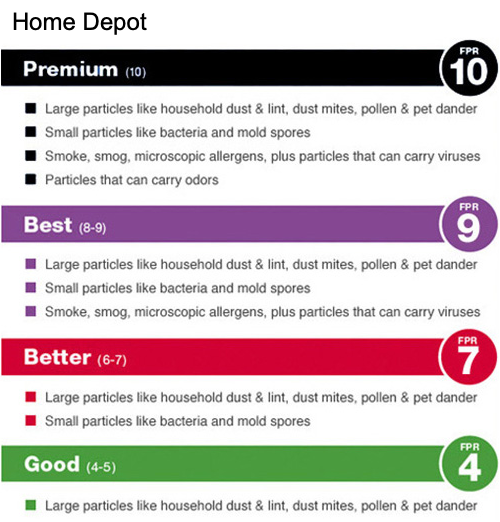
Source: Best Air Filters for Your Home - The Home Depot
3M Filtretes
Filtretes above MPR 300 have fibers with a permanent electrostatic charge. That charge lets filter media fibers capture teeny-tiny particles much more efficiently—without restricting airflow.
| Model | MERV | Particle
Size
(micron) | 1-3 | 3-10 | Carbon
Layer* |
| 0.3-1 | 1-3 | 3-10 |
| MPR 1200 | 11 | | | | * |
| MPR 1900 | 13 | 62% | 87% | 95% |
| MPR 2800 | 14 | 81% | |
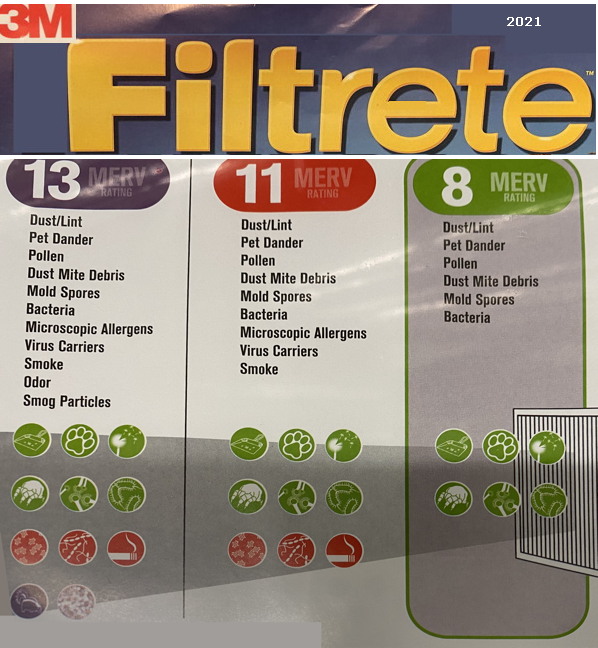
I copied this chart from a label in the store on the same day as the above. They seem to be inconsistent. The char above shows the MERV 13 has odor elimination, but the one below does not.
Their web site indicates the MERV 11 filter is the only one with a carbon layer.

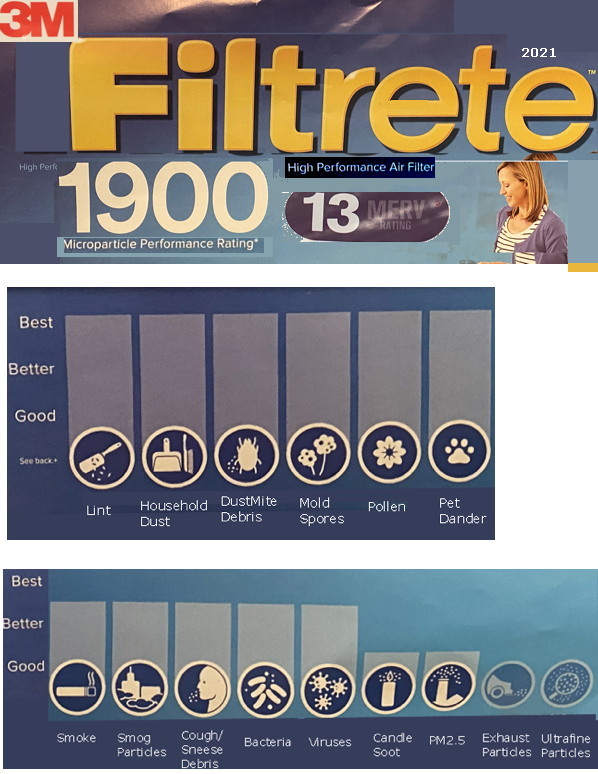
How Often Should I Change The Air Filters In My Home? | AADC
The replacement frequency depends on the size of a filer.
The 5 inch 1500 MPR 3M filters sold at Lowes and ACE say 12 months.
The 1 inch 1500 MPR 3M filters say 3 months.
Replacement:
Fiberglass filters need to be replaced every 30 days.
Recommended furnace filters replacement is as follows: MERV 8 every 3-4 months, MERV 10 and 11 every 6 months, MERV 16 every year. If you have pets it is recommended that you check your filter monthly because having pets tends to send more particulates into the air. Source: MillersHeating.com
| Conditions | Filter thickness |
| 1 - 2 in | 4 in | 5 in |
| Baseline | 3mos | 6 mos | 12 mos | |
| Animals | 1/month | 2 mos | 3 mos |
| 1 animal | 2 mos | 4 mos | 6 mos |
| Dusty | 1/month | 2 mos | 3 mos |
| Moderate dust | 2 mos | 4 mos | 6 mos |
| Always leave fan on | 1/month |
| Occasionally leave fan on | 2 mos. |
How Often Should You Replace Your Furnace Filters? | Newport News, VA
Technical Specifications - Flow Restriction - Dependency on :
Honeywell FC100A1029 - 16" X 25" r
Static Pressure Drop (in. w.c.) - 0.23 at 500 FPM
FC100A1003 - Honeywell FC100A1003 - 16" X 20" Media Air Filter MERV 11 (at 492 FPM)
Replacement Size:
Not all filters are the same actual size.
20x25x5 Air Filters | AC and Furnace Filters at Filter Buy
"Confused with all the choices of 20x25x5 filters? You’re not alone. Even though these filters carry the same nominal size, they range from only 4.25” thick to over 5.25” thick. The difference in these sizes is just enough to make them unique and not interchangeable.
Unfortunately, the fact that they are not interchangeable is not a coincidence. The major HVAC brand manufacturers would prefer you to purchase their (overpriced) OEM replacements for your unit. Given there are so many different varieties, no local box store can stock them all."
My Honeywell MicroDefense CF508A1625/E 16x25x5 was actually
15 3/4 x 24 3/4 x 4 3/8
A Lennox OEM Merv 11
15-3/4" X 24-3/4" X 4-3/8"
A replacement 3M Filtrete 1550 MPR Ultra Allergen at Lowes & Ace was.
15 3/4 x 24 1/8 x 4 7/8 with 1/4" foam at the top and bottom, so it could fill a 16 1/4' opening..
It said it was designed to fit Honeywell and Lenox.
It was too wide to fit in my HVAC system. I had a new Lenox unit but the duct work still included the old Honeywell filter slot designed for for an electrostatic filter.
At FilterBuy.com they say.
"Even though these filters carry the same nominal size, they range from only 4.25” thick to over 5.25” thick.
Unfortunately, the fact that they are not interchangeable is not a coincidence. The major HVAC brand manufacturers would prefer you to purchase their (overpriced) OEM replacements for your unit. Given there are so many different varieties, no local box store can stock them all."
FilterBuy.com has a large selection of replacements.
Filter at Lowes (click to enlarge)
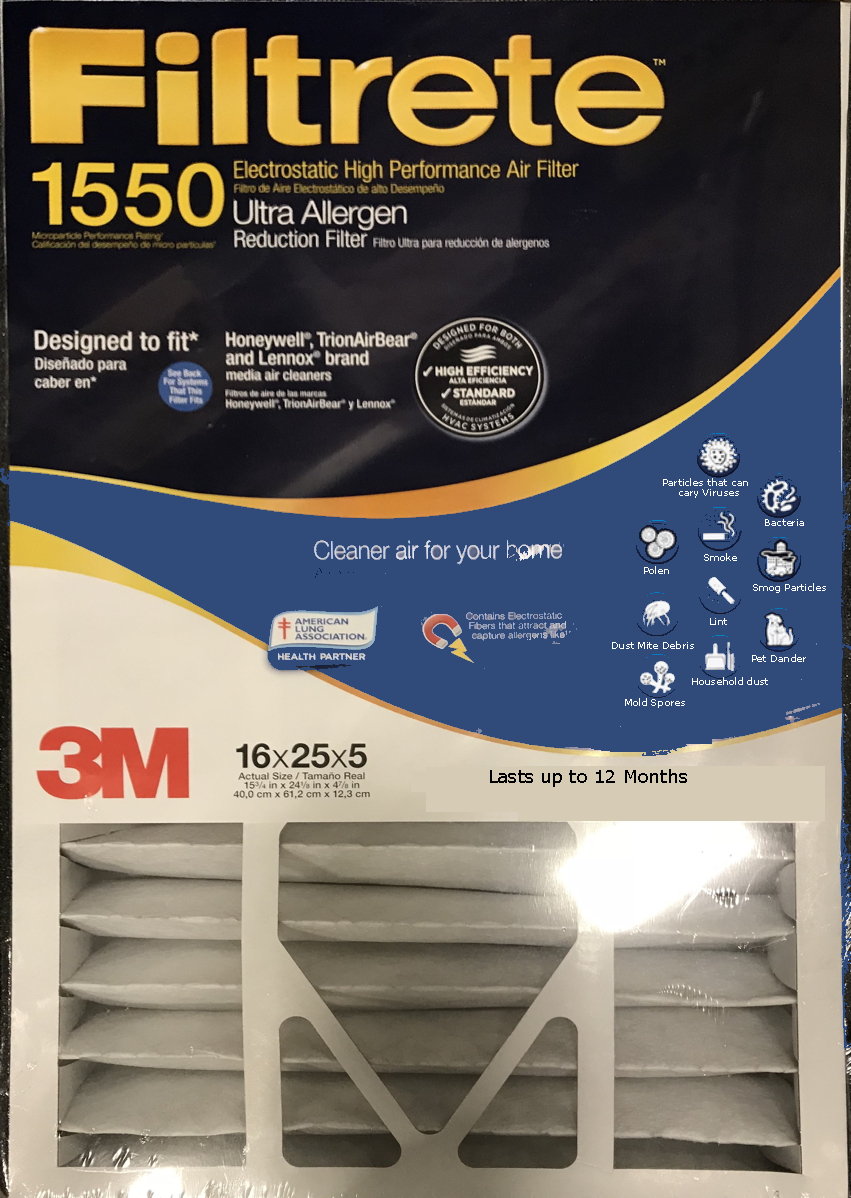
Links:
Air Filter Particle Size chart
National Air Filtration Association (NAFA) User's Guide
Filter Effeciency
Quick Reference Comparison of ASHRAE Std. 52.2 and Std. 52.1
A Guide to Understanding HVAC Filter Selection
Ultra-web technology
last updated 13 Mar 2008
|
 Home & Garden
Home & Garden
 Air Filters
Contact
Air Filters
Contact
 Home & Garden
Home & Garden
 Air Filters
Contact
Air Filters
Contact


 1. Behind the return duct grills in the ceiling or on a wall in the house. Usually a 1 inch thick filter.
1. Behind the return duct grills in the ceiling or on a wall in the house. Usually a 1 inch thick filter.